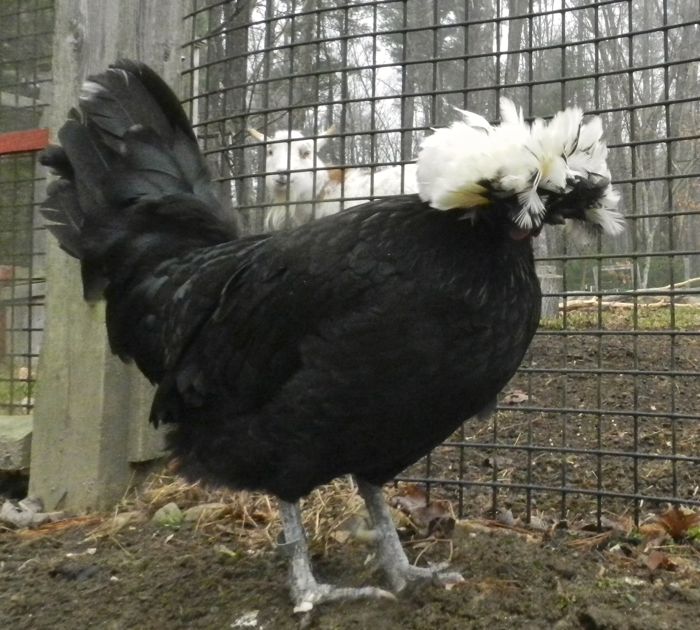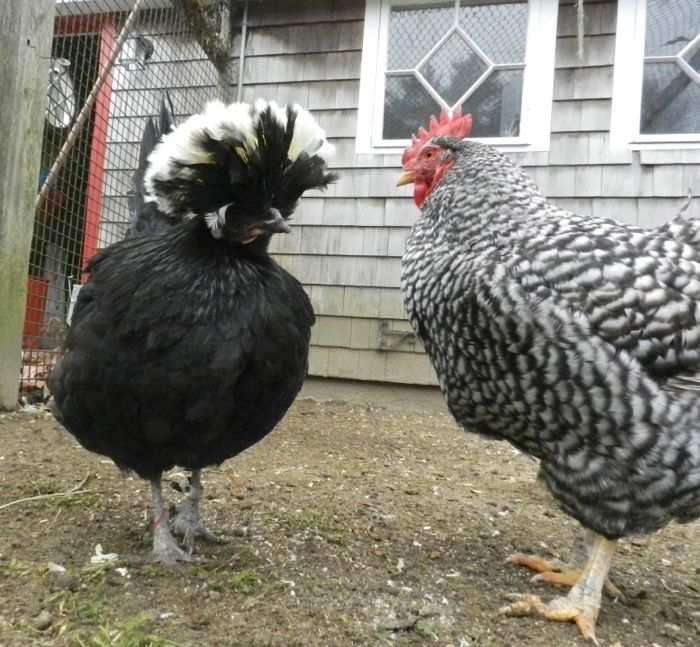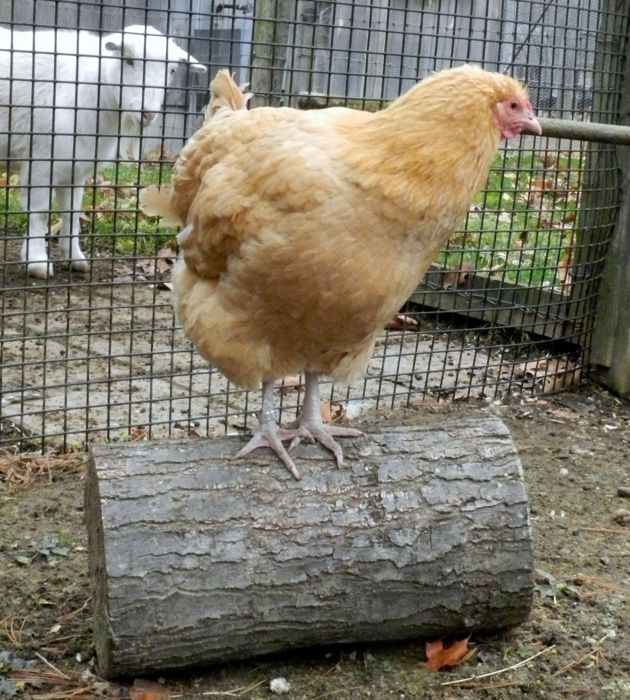The six hens that you see on the HenCam are old. Very old. Historically, even the utility birds that scratched around the farmyard laid eggs for two seasons and then went into the stewpot. No one breeds for longevity. Looks and productivity for the first two years are what matters. By the age of three many hens die simply because their systems wear out. Others succumb to predators and disease. Tumors and cancer are prevalent. But, some chickens, like Tina, Siouxsie, Betsy, Edwina, Buffy and Twinkydink, keep on ticking. I’ve helped my old girls to beat the odds. The Spa Treatment has revived them. A good diet and a dry, clean environment keeps disease at bay. Still, these girls are ancient, and they are showing it.
At only 3 1/2, the Polish are the comparative youngsters of the group. Decorative hens like Polish, that are not high-producing layers, often have comparatively long lives. Still, these two, Siouxsie and Tina, have never been robustly healthy. They’ve been prone to respiratory diseases and laying issues. Recently, Siouxsie has been gasping and she’s been having trouble getting off of the roost in the morning. I believe that she has an internal issue that is incurable and is letting it run its course. Siouxsie continues to eat and seems oblivious to her ailment. She could keep on like this for quite awhile. I’ll be trimming her top knot back again. It wouldn’t hurt for her to be able to see where she’s going.
Her sister, Tina, is breathing fine, but the bumblefoot is back. It’s not as bad as when it first appeared, and today I’ll soak her foot in epsom salts and see if I can alleviate some of the swelling. But, it doesn’t seem to be bothering her. Here Tina is standing around with Edwina. At 7 1/2, Edwina is a grand old dame. She’s been a sturdy, healthy hen her entire life. A hen like this could live for a few more years.
Twinkydink arrived with Edwina, and she, too, never seems to be troubled by anything. Buffy, however, has had one ailment after another. She’s 6 1/2, which is about the limit for an Orpington that in her day was a good layer. Lately, Buffy has been resting a lot and sitting on her hocks. In this photo you can see how different her stance is than Twinkydink’s.
But then just when I think that Buffy is breathing her last breath, she gets up on her thinking log and looks fine.
I don’t expect all of these hens to live through the winter, but then again, they epitomize the expression, “tough old birds,” and I think they’ll be sticking around for awhile longer.





I hope that Siouxsie recovers and Tina’s bumblefoot eases with your treatment. And I’m rooting for Buffy. I love that she has a thinking log! Thanks for the update.
After inspection of the foot, it appears that Tina has a solid but inert mass in her foot. There’s no swelling above it. I did clean things up and use a disinfectant, but otherwise will leave it alone.
Glad to hear that Tina’s bumblefoot is inert. I’m new to chicken-keeping (my three are only 8 mos old) but I’m so glad that I found your blog because you give such calm and detailed instructions on how to handle these medical problems. And I hope that my girls live long and happy lives like your hens…though you are right about barred rocks being tyrants when young. I have two and they don’t let the easter egger (who is moulting!) get any good treats.
Terry, my birds are 5 and a half years old. Last Easter we had to put one down due to what was mostly likely internal laying. We had a compassionate vet euthanize her before she starved to death. It was really hard.
But now when I look at the other girls, all I can think about is when’s the next one going to go. Focusing on their endtimes is stealing my enjoyment of their current health and cuteness.
Do you struggle with that too when you look at your “old girls”?
I try to look at my old animals with the perspective that each day is a surprise and a gift, not a loss. That perspective helps. It also helps to have young ones in the mix so that it doesn’t seem as if you’re waiting for everyone to die. Perhaps you need to start perusing those chick catalogs and get a couple of new birds this spring.
I guess, like all of us, they have good days and bad days when they don’t want to get out of bed! I do know that they are in the best place possible for lots of tender love and care. Thanks for sharing the info for all of us who share your menagerie with you.
On a lighter note, I was having a rotten day at work yesterday and am hacking from a cold. I clicked on the hen cam and there was HRH Candy, sittlng in her zen bunny position. It really helped brighten my day. Thanks for your (and Candy’s) public service!
There are several nasty bugs going around, sorry you have one, but glad my girls could provide some relief. While I was inside the barn dosing Tina’s foot, I heard a clatter and Candy came charging in to eat out of the chicken feeder. Wish you had seen that.
Me too! Thanks for the well wishes and your girls (and goat boys) always bring a smile. Thanks!
It’s only now that we have 3 young pullets again, that we realise how the older hens have slowed down. We still have Phoebe aged 6 and the 3 ‘Spice Girls’ aged 4+ who are fine and in good health but gosh! the new youngsters are so quick and nimble!!!
Celia
x
Yes, if I didn’t have the Gems I wouldn’t realize how slow my old girls are.
A sweet story. And sad too, in that the awful fact of hen life is that we have been breeding the life out of them all this time. Nevertheless when I think about all the eggs my girls produce for my benefit, I firmly believe in their earned retirement with as much comfort and dignity I can give them.
Agreed.
I enormously appreciate your site and your attitude toward your animals! But I would like to do a little cheering (as an occasional meat-eater) for the priniciple of trying to only eat meat from animals that haven’t suffered. From animals that I have taken responsibility for. Also the responsibility of slaughtering — as humanely as possible. (I am grateful that you brought some detailed information about this recently.)
Getting chickens, assuring them two years of a wonderful, free-ranging life, gathering their eggs with enthusiasm every day anew, and then “promoting” them to the deep-freezer (no cynicism intended) seems to me a great privilege that I wouldn’t have, for example, as a city dweller. (And most chickens wouldn’t have, either.) Most people I know blanch at the idea of slaughtering own animals but don’t really hesitate much about buying meat of animals that have been kept in mass stocks. I really don’t understand this.
Susan, I absolutely agree with you. Because I have only a few chickens, I get to know them very well and do not care to eat them. But I have friends who keep meat birds and respect what they do. It’s easier to harvest laying hens when you have all of one breed and you don’t name them! I try to buy all of my meat from local farmers who raise and slaughter their animals with care. I eat less meat, but what I eat is very good!
I wish all the girls good health. It does appear that Pip is offering sage advice and comfort to Buffy.
Yes, but getting to know them individually is hard to avoid with small flocks. (Mine are all of one breed but differently colored, so I can tell them apart). I had 13 chickens until last week. Then a hawk got “Emma”, my favorite. She was the best layer and the only one with a name, given for her “Emma”-nicipation from the rest of the flock, liking to be on her own in remote corners of the lot. But her being on her own was her doom. (The hawk, incidentally, didn’t bother to kill her before partaking of his meal. We had to put her out of her misery.)
We are still upset, but in some way accepting. That’s the way of nature: eating and being eaten…
Incidentally, Emma belonged to a group without a rooster. The other six have a watchful protector who shoos them under the bushes when shadows are lurking from above. So in the future we will only have groups of around 6 hens with a rooster.
I’ve seen Pip and Buffy in that very position before. I think they are communicating.
They are. And Candy goes over and has a confab with the goats every evening before bedtime. Lots of interspecies friendships and communication here.
This may come off as a sort of stupid question, but do you eat the occasional eggs the old chickens lay? Does their age effect the taste of the eggs? Because if they get so sick often, it seems it would. Haha. Thanks! :)
Actually, a great question! My old hens are not on any medications,so there is nothing bad in their eggs. Perfectly edible. However, old hens tend to lay thin-shelled eggs, and if the shell is cracked I discard them (as that’s an entryway for pathogens.) Their eggs also seem to have a grittier texture, best for baking when it’s not noticeable, and not poaching when you would.
My Blue Orpington(June), hardly has any comb, like your Buffy. Is this common with Orpington`s?
Buffy’s comb has partly fallen off and partly been pecked at (do an blog archive search for that tale), but it did start out small. Orpingtons are cold hardy, and one reason that they do well in winter temps is because they have compact combs not prone to freezing.
Do you think Terry, if you ever get any more Polish, that you might decide to buy some retired show bird such as your bantam leghorns ? Maybe of a line that is breeding for a longer lived Polish hen, so they can show them more longer and more often ?
The “fancy” breeders don’t select for longevity. I do not have a problem with chickens having short life spans. Many animals, especially birds, do. What I try to get across is that people, like myself, who keep them for longer than their naturally healthy lifespan of 3 years will have to deal with many issues. It’s not something that people getting into backyard chicken keeping think about, but it’s essential that they do!
I love my birds, but when you have a small yard it’s not a super terrible thing that they pass shortly after they stop laying regularly. Yes they are pets, but my main purpose for getting them was because I hated supporting factory egg producers, and I can only fit so many chickens in my yard… Though funny enough I have this crazey blue silkie, who is in the 3 yeard range and she lays consistantly everyother day, with the exception of when she goes broody, which can quite literally last for 3 months at a rip, I have stopped fighting her on this, she is the only bird I have that makes me nervous she can be a little Kujo.
Well put, Jonathan. Those of us with backyard hens that we don’t harvest for meat at the age of two, straddle a line between practicality and indulgence. I don’t think it’s always best to treat the hens as coddled pets, as so few of them have a healthy old age like Twinkydink. Far more of them waste away like Siouxsie. I don’t believe in extending their lives with expensive (and often ineffective) vet visits. Keep them comfortable, but let them go when they are no longer vibrant animals. It might sound heartless, but it’s actually better, I think, when they pass away quickly, as many do, at the age of three.
The reality of chickens’ normal laying period has been an unwelcome surprise to me. Yes, I read books and magazines before I got my first chicks, 2.5 years ago. But there was only so much pure information I could take in from that kind of research, and some of the finer details went by the wayside, only to reappear once I got my girls and started hands-on learning.
Initially, I told myself (and ‘promised’ my girls) they could live until they died naturally — that I wouldn’t replace them when they slowed down their laying. But I didn’t fully grasp just how quickly they slowed down. Our city ordinance allows only 4 ‘poultry’ animals per lot. Which is fine in theory, I guess — 4 hens, 4 eggs/day — again, in theory.
But in practice, of course chickens don’t always lay an egg a day, and in winter they slow down or stop, depending on breed and age. So for those of us who can happily eat 4 eggs a day, what are our choices? Stop eating eggs when there are none (obviously what was done in earlier times)? Buy supplementary eggs at the grocery store? Alas, the local pasture-raised chickens also stop laying in the winter, so buying eggs at this time of year means I can’t be certain they are not prison-laid. Or cheat, er, stretch the rules, by having more than the statutory 4 hens?
That has been my choice. I currently have 7 — which is about all my coop and hen yard can handle. I can’t let my girls free range much because the only place they can go is my garden, and they are too destructive to let them out more than a few times during the winter months.
I now have a mix of ages. 2 girls finishing up their third laying season. 2 finishing up their second, and still laying fairly well. 3 new girls, still laying daily as the winter comes on. But next year? In theory I would practice triage, and either give some or all of the older girls away (so far I’ve done this on craigslist, though of course there is no guarantee they really are going into someone’s flock rather than the stewpot). But I have become so attached to them — even the really aggravating ones are fun to have, because of their personalities.
In my perfect world, I would build a second henhouse and coop, and get 4 new pullets each year, rotating out the 3 year-olds. But that’s not going to happen. I would feel better about such a plan if the city would increase the maximum flock number to 8 or 12.
So urban chicken ranching is challenging, beyond the basic facts of feeding, watering, health care and ahem — treat-giving. I envy you your two flocks! I keep my fingers crossed that no one reports me for having too many chickens! And enjoy seeing and hearing about your gang every day.
You’ve explained the backyard chicken keeper’s dilemma perfectly. These animals have a purpose, and they outlive that. We have only a few hens that we know very well, so not many of us want to eat them after two years. Much to think about.
Terry what is you suggestion for withdrawal period for eggs after giving antibiotics? Everywhere you look its a differant answer for 10day to 21 days and everything in between. I know I have asked you this before but can’t find that email. I think I deleted it.
I just read you FAQ and it said 10 days, I should have looked there first. SORRY! :-) I gave Duamycin-10
See, and here I’ve given you contradictory advice to my own post! :) I believe that 10 days is what is advised for Duramycin. Some drugs have no withdrawal period. Very confusing. The more that I read about the problems with overuse of antibiotics in the commercial sector, the more I worry about what I do at home, and so I’ve become more cautious.
Ehh, you know these commercial egg producers use so antibiotic, that I don’t think us using antibiotics once or twice a years, is a terrible thing.